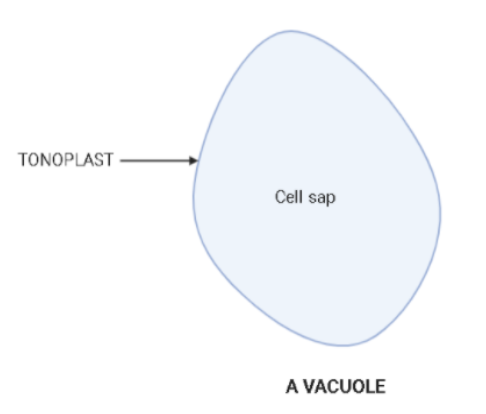
What are vacuoles? Name their types and functions.
Answer
516.6k+ views
Hint: The majority of the structure of a living system is composed of carbohydrates, proteins, fats and nucleic acids. The composition of carbohydrates, proteins, fats and nucleic acids to find the majority of elements present in the body.
Step by step answer:Vacuoles are membrane-bound cavities found inside both eukaryotic and prokaryotic cells that often carry watery liquid or gases. These are small storage bundles which contain water with inorganic and organic substances. Contractile vacuole was the first discovered vacuole in protozoan. A vacuole is surrounded by a membrane called tonoplast, is biochemically similar to the cell membrane. Plant cell carries a single large-sized vacuole while an animal cell has multiple small vacuoles.

Vacuoles are of 4 types:
Sap Vacuole: Several small sap vacuoles occur in animal cells and young plant cells. In plant cells, small vacuoles fuse to form a single large central vacuole that occupies the maximum volume of the cell. It facilitates rapid exchange between the cytoplasm and the surrounding environment. The fluid present in the sap vacuoles is often called a sap or vacuole sap.
Contractile Vacuoles: They occur in some protistan and algal cells found mostly in freshwater. It has a highly extensible and collapsible membrane. They pour the same into the contractile vacuole. The vacuole swells up (diastole). The swollen contractile vacuole comes in contact with the plasma membrane and collapses (systole). This throws the vacuole contents to the outside. Contractile vacuoles are imperative for osmoregulation and excretion.
Food Vacuoles: These vacuoles occur in the cells of protozoan protists, some lower animals, and phagocytic higher animals. A food vacuole originates from the fusion of a phagosome and a lysosome. The food vacuole contains digestive enzymes for the breakdown of the nutrients. The digested materials are passed out into the surrounding cytoplasm.
Air Vacuoles (Pseudo-vacuoles, Gas vacuoles): Found in prokaryotes, they are not a single entity, neither is it surrounded by a common membrane. It consists of several smaller sub-microscopic vesicles. Each gas vesicle is surrounded by a protein membrane that encloses metabolic gases. Air vacuoles store gases and also provide buoyancy and mechanical strength.
Note: Vacuoles are membrane-bound organelles that are found in both prokaryotes and eukaryotes cells. Vacuoles are of 4 types: Food vacuole, Sap vacuole, Gas vacuole, Contractile vacuole.
Step by step answer:Vacuoles are membrane-bound cavities found inside both eukaryotic and prokaryotic cells that often carry watery liquid or gases. These are small storage bundles which contain water with inorganic and organic substances. Contractile vacuole was the first discovered vacuole in protozoan. A vacuole is surrounded by a membrane called tonoplast, is biochemically similar to the cell membrane. Plant cell carries a single large-sized vacuole while an animal cell has multiple small vacuoles.

Vacuoles are of 4 types:
Sap Vacuole: Several small sap vacuoles occur in animal cells and young plant cells. In plant cells, small vacuoles fuse to form a single large central vacuole that occupies the maximum volume of the cell. It facilitates rapid exchange between the cytoplasm and the surrounding environment. The fluid present in the sap vacuoles is often called a sap or vacuole sap.
Contractile Vacuoles: They occur in some protistan and algal cells found mostly in freshwater. It has a highly extensible and collapsible membrane. They pour the same into the contractile vacuole. The vacuole swells up (diastole). The swollen contractile vacuole comes in contact with the plasma membrane and collapses (systole). This throws the vacuole contents to the outside. Contractile vacuoles are imperative for osmoregulation and excretion.
Food Vacuoles: These vacuoles occur in the cells of protozoan protists, some lower animals, and phagocytic higher animals. A food vacuole originates from the fusion of a phagosome and a lysosome. The food vacuole contains digestive enzymes for the breakdown of the nutrients. The digested materials are passed out into the surrounding cytoplasm.
Air Vacuoles (Pseudo-vacuoles, Gas vacuoles): Found in prokaryotes, they are not a single entity, neither is it surrounded by a common membrane. It consists of several smaller sub-microscopic vesicles. Each gas vesicle is surrounded by a protein membrane that encloses metabolic gases. Air vacuoles store gases and also provide buoyancy and mechanical strength.
Note: Vacuoles are membrane-bound organelles that are found in both prokaryotes and eukaryotes cells. Vacuoles are of 4 types: Food vacuole, Sap vacuole, Gas vacuole, Contractile vacuole.
Recently Updated Pages
Master Class 11 Economics: Engaging Questions & Answers for Success

Master Class 11 English: Engaging Questions & Answers for Success

Master Class 11 Social Science: Engaging Questions & Answers for Success

Master Class 11 Biology: Engaging Questions & Answers for Success

Class 11 Question and Answer - Your Ultimate Solutions Guide

Master Class 11 Business Studies: Engaging Questions & Answers for Success

Trending doubts
1 Quintal is equal to a 110 kg b 10 kg c 100kg d 1000 class 11 physics CBSE

What is a periderm How does periderm formation take class 11 biology CBSE

What are porins class 11 biology CBSE

Why is steel more elastic than rubber class 11 physics CBSE

Differentiate between red algae and brown algae class 11 biology CBSE

What is boron A Nonmetal B Metal C Metalloid D All class 11 chemistry CBSE




